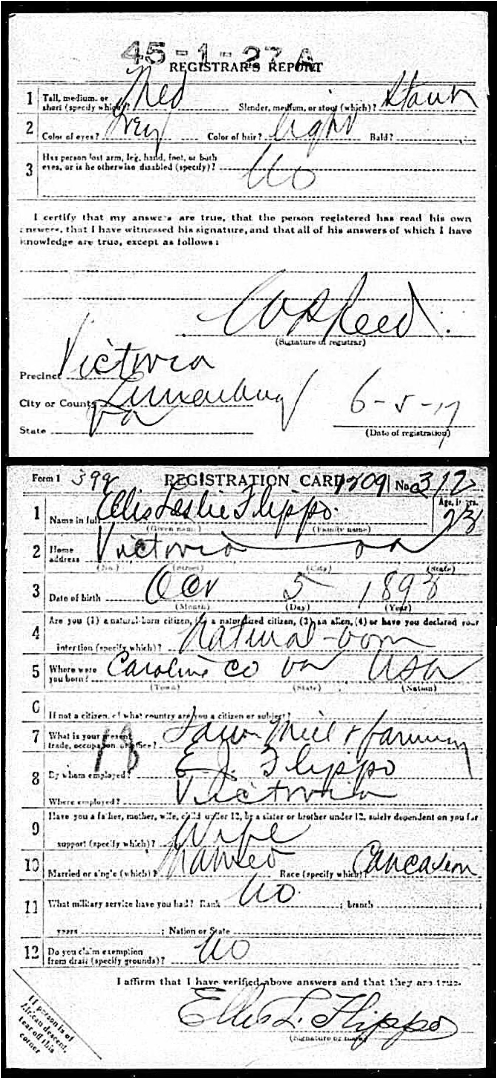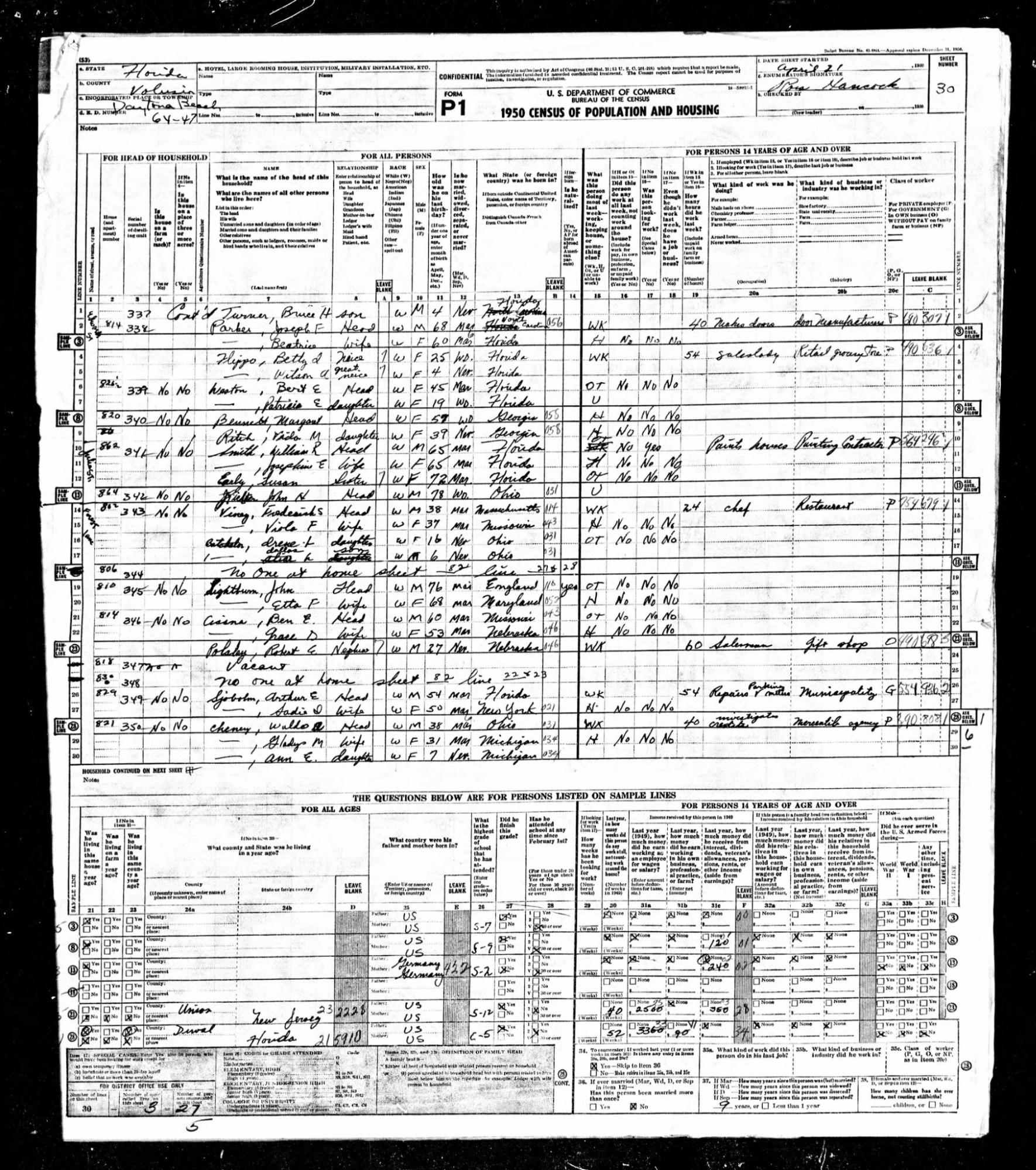Wilson Mayes Flippo (April 27, 1924-May 2, 1945)
33rd Photographic Reconnaissance Squadron, 363rd Tactical Reconnaissance Group,
9th Air Force
By Lisa Bostick and Melissa Rosero-Barros
Early Life
Wilson Mayes Flippo was born April 27, 1924 in Chesterfield, VA to Ellis and Olive Flippo.1 He lived with his parents and his older siblings Ellis Jr. born in 1919, Mildred born in 1921, and Kathleen born in 1923. By early 1930, the family relocated from Virginia to Florida where they owned their house in Volusia County.2 They subsisted on the sole income of the family farm, delivering their produce to the surrounding area.3
The agricultural industry, which had been previously flourishing prior to the first World War, took a massive hit when a drought and the on-set of the Depression raised the prices for seeds.4 Worsening conditions in Florida–the crash of the 1920s Florida’s land boom, several hurricanes in the late 1920s and an invasive species of fruit fly–-devastated the citrus industry causing land to depreciate in price.5 The Flippo family, affected by the economic downturns in their native Virginia, must have believed that the cheap farmland in Florida offered more opportunities for the family–an attractive option for many agricultural workers from the rest of the American South– who flocked south to the Sunshine State.6
The Flippos made the journey to Florida when Wilson was only five years old.7 Ellis worked as a meat butcher while Olive continued to care for the home.8 By 1935, the family went back to farming as they settled into their new community.9 The farm was lucrative enough for all the Flippo children to be able to attend school. Ellis and Olive were both able to attend classes at a community school, while Wilson attended High School along with his two older sisters.10
The Selective Service and Training Act instituted in September of 1940 was the first peacetime draft in United States’ history.11 By the time Wilson graduated highschool in 1942, he joined the fifty million young men that registered for the draft over the course of World War II.12 Wilson’s father also registered for the military during the First World War, being registered for the draft almost exactly twenty-three years before as seen in his registration record.13
Despite the impressive numbers of registered soldiers, registration for the youngest member of the Flippo family was considerably easier than other young members of other races. In 1942, the National Association for the Advancement of Colored People became involved in the fight for the end of discrimination against African Americans in the armed services and defense industry. The pressure from this fierce public display resulted in President Roosevelt to sign Executive Order 8802 which prohibited racial discrimination in the defense industry.14
Military Service
Wilson enlisted into the Army Air Force (AAF) in December of 1942 at Camp Blanding near Starke, FL.15 There, Wilson joined one of the largest military training outposts in the state; with the camp boasting up to 55,000 soldiers at a time.16 Sometime after Wilson finished his training, the AAF assigned him to the 33rd Photographic Reconnaissance Squadron (PRS).17 Photographic reconnaissance squadrons flew aircraft equipped with cameras. Missions included taking photographs of battlefields, enemy positions, and potential bomber targets.18 All of this intelligence provided assistance to ground commanders, which reflected the importance of aerial photographic intelligence.19 Throughout 1943 and early 1944, the 33rd PRS belonged to the III Reconnaissance Command and trained in North Carolina, Texas, and Oklahoma.20 While in Oklahoma, in January of 1944, Wilson contracted hookworm and a steatoma. He recovered in the base’s hospital.21
In April of 1944, Wilson and his comrades deployed to the European Theater and arrived in Chalgrove, England on the 27th. Shortly after the 33rd PRS arrived, the AAF reassigned it to the 10th Photographic Group. By this time, the 33rd PRS flew the modified P-38 Lightning designated as the F-5.22 The P-38 was a multi-role, fighter-bomber aircraft developed by Lcokheed and introduced in 1941. Lockheed modified the P-38 to meet the AAF’s need for a reliable, high altitude, long range reconnaissance aircraft. The F-5 carried up to six cameras mounted in the gunports and fuselage of the aircraft. Because of this design, the F-5 was unarmed. Pilots relied on altitude and speed to accomplish their, often solo, missions. Upon landing, photographic technicians met the aircraft to retrieve the film from the cameras and rush it to the lab for processing. Because of the necessity to wait for the plane to land in order to get the photographs, this meant if a F-5 did not return the photographs were lost as well.23
The 33rd PRS continued to fly missions over Europe out of England until August 15 when the squadron moved to France. First in Le Molay, about ten miles inland from Omaha Beach in Normandy, then Toussus le Noble, about 20 miles southwest of Paris. The squadron kept up with the pace of the front and moved into Belgium on September 21. At the end of October, the 33rd PRS transferred to the newly reformed 363rd Tactical Reconnaissance Group (TRG).24 Wilson returned home in November of 1944 and married Betty Rickerson on the 27th.25 He likey returned to his unit sometime during the Battle of the Bulge, in December of 1944. During the battle, the 363rd TRG’s squadrons flew reconnaissance missions whenever the weather permitted.26
After the conclusion of the Battle of the Bulge at the end of January of 1945, the Allies started pushing east once again. In March of 1945, the 33rd PRS left Belgium for Venlo, Holland, just a couple miles from the German border. As the Germans fell back over the Rhine, the squadron entered Germany and, on April 16, set up operations about 100 miles inside its borders at Gutersloh. The 33rd PRS only operated from there for about ten days and moved to Brunswick on April 25.27 Just days before the conclusion of the war in Europe, Wilson Mayes Flippo lost his life. After his death on May 2, 1945, his comrades buried him in Holland.28
Legacy
For Wilson Mayes Flippo's efforts during the war, he posthumously received the American Campaign Medal and the World War II Victory Medal.29 Following Wilson’s death, the 33rd PRS remained in Germany. After Victory in Europe on May 8, 1945, the squadron moved to Eschwege in central Germany. Flippo’s unit remained in Eschwege until August 23, when it started the journey back to the US. The 33rd PRS arrived at Camp Myles Standish in Taunton, MA on October 3, 1945. The AAF inactivated the squadron the following day.30
After Wilson’s death, Betty moved to Daytona Beach to live with her great uncle and aunt. According to the 1950 federal census, Betty lived in Daytona where she lived with her four year-old daughter who was named in honor of Wilson.31 She pursued an education while working as a cashier at the local Piggly Wiggly before remarrying to John Ragland in 1962.32 In 1949, as part of the Return of the Dead Program, Betty decided to bring Wilson’s remains back to the US. He returned to Florida and was reinterred in the St. Augustine National Cemetery on April 20, 1949. He now rests among his fellow Veterans in Section D, Plot 129.33
Endnotes
1 “1920 United States Federal Census,” database, Ancestry (ancestry.com: accessed April 20, 2024), entry for Ellis L. Flippo, Henrica, Virginia. ; “U.S., National Cemetery Interment Control Forms, 1928-1962,” database, Ancestry (ancestry.com: accessed April 20, 2024), entry for Wilson Flippo.
2 “Florida, U.S., State Census, 1867-1945,” database, Ancestry (ancestry.com: accessed April 20, 2024), entry for Wilson Mayes Flippo, Volusia, Florida.
3 “Florida State Census,” Ancestry.
4 “Rural Life in Virginia,” Business and Industry, Virginia Museum of History and Culture, accessed April 20, 2024.https://virginiahistory.org/learn/rural-life-virginia
5 “Hurricane of September 20th, 1926,” National Weather Service, accessed June 20, 2024, https://www.weather.gov/mob/1926Hurricane; “Memorial Web Page for the 1928 Okeechobee Hurricane,” National Weather Service, accessed June 20, 2024, https://www.weather.gov/mfl/okeechobee.
6 “Migrant Workers During the Great Depression,” Photo Exhibits, Florida Memory, accessed April 23, 2024. https://www.floridamemory.com/learn/exhibits/photo_exhibits/migrant/
7 “1930 United States Federal Census,” database, Ancestry (ancestry.com: accessed April 20, 2024), entry for Wilson Mayes Flippo, Volusia, Florida.
8 “1930 United States Federal Census,” Ancestry, entry for Wilson Mayes Flippo.
9 “Florida State Census,” Ancestry.
10 “Florida State Census, Ancestry; “1940 United States Federal Census,” database, Ancestry (ancestry.com: accessed April 20, 2024), entry for Wilson Mayes Flippo, Volusia, Florida.
11 “Research Starters: The Draft and World War II,” The National World War II Museum: New Orleans, accessed July 1, 2024. https://www.nationalww2museum.org/students-teachers/student-resources/research-starters/draft-and-wwii#:~:text=The%20Draft%20and%20WWII,draft%20in%20United%20States%27%20history
12 “U.S., World War II Army Enlistment Records, 1938-1946,” database, Ancestry (ancestry.com: accessed July 1, 2024), entry for Wilson M. Flippo.;“ U.S., World War II Draft Cards Young Men, 1940-1947,” database, Ancestry (ancestry.com: accessed April 20, 2024), entry for Wilson Mayes Flippo, Daytona Beach, Florida.; “The Draft and World War II,” The National World War II Museum.
13 “U.S., World War I Draft Registration Cards, 1917-1918,” database, Ancestry (ancestry.com: accessed April 20, 2024), entry for Ellis L. Flippo, Lunenburg County, Virginia.
14 Keri Pleasant, “Honoring Black History World War II Service to the Nation,” U.S. Army, February 7, 2020. Accessed April 17, 2024. https://www.army.mil/article/233117/honoring_black_history_world_war_ii_service_to_the_nation#:~:text=During%20WWII%2C%20more%20than%202.5,the%20Army%20during%20the%20War. ; While Executive Order 8802 ended racial discrimination in government (and military) hiring processes, racial discrimination would continue throughout governmental agencies with non-white individuals being relegated to lower positions with little to no opportunities of advancement. It would not be until Truman’s presidency that another Executive Order would be made to end segregation in the military.
15 “World War II Enlistment Records,” entry for Wilson M. Flippo.
16 “Florida in World War II,” National Park Service, Accessed July 1, 2024. https://www.nps.gov/casa/learn/historyculture/florida-in-world-war-ii.htm
17 Department of Military Affairs, St. Augustine National Cemetery Index and Biographical Guide: Preliminary Abridged Edition (St. Augustine, FL: St. Francis Barracks Special Archives, 1989), 214; “U.S., National Cemetery Interment Control Forms, 1928-1962,” entry for Wilson Flippo.
18 “33rd Photographic Reconnaissance Squadron,” American Air Museum in Britain, Accessed July 1, 2024. https://www.americanairmuseum.com/archive/unit/33rd-photographic-reconnaissance-squadron
19 Christopher M. Rein, Forging the Ninth Army-XXIX TAC Team The Development, Training, and Application of American Air-Ground Doctrine in World War II, (Fort Leavenworth: Army University Press, 2015), pgs. 27, 82. https://www.armyupress.army.mil/Portals/7/combat-studies-institute/csi-books/leavenworth-papers-24-forging-the-ninth-army-xxix-tac-team.pdf
20 Maurer Maurer, Combat Squadrons of the Air Force; World War II (USAF Historical Division, Department of the Air Force, 1969), 162.
21 “US, WWII Hospital Admission Card Files, 1942-1954,” database, Fold3 (Fold3.com: accessed April 20, 2024), entry for Wilson M. Flippo.
22 Maurer, Combat Squadrons of the Air Force; World War II, 162.
23 “F-5 Lightning Development,” 34th Photo Reconnaissance Squadron, 2024, https://www.34thprs.org/html/aircraft/F5dev.html.
24 Maurer, Combat Squadrons of the Air Force; World War II, 162.
25 “Florida, U.S., Marriage Indexes, 1822-1875 and 1927-2001,” database, FamilySearch (familysearch.com: accessed April 20, 2024), entry for Wilson M. Flippo, Volusia, Florida.
26 Rein, Forging the Ninth, 110; “363rd Fighter Group,” American Air Museum in Britain, Accessed May 2, 2024. https://www.americanairmuseum.com/archive/unit/363rd-fighter-group
27 Maurer, Combat Squadrons of the Air Force; World War II, 162.
28 “U.S., National Cemetery Interment Control Forms, 1928-1962,” entry for Wilson Flippo.
29 “Wilson M. Flippo,” Honorstates.org, Accessed April 20, 2024. https://www.honorstates.org/profiles/446214/
30 Maurer, Combat Squadrons of the Air Force; World War II, 161-162.
31 “U.S., City Directories, 1822-1995,” database, Ancestry (ancestry.com: accessed April 20, 2024), entry for Betty Flippo, Daytona Beach, Florida, 1949.; “1950 United States Federal Census,” database, Ancestry (ancestry.com: accessed April 20, 2024), entry for Betty Flippo, Daytona Beach, Florida.
32. “U.S., City Directories, 1822-1995,” database, Ancestry (ancestry.com: accessed April 20, 2024), entry for Betty Flippo, Daytona Beach, Florida, 1951.; “1950 Federal Census,” Ancestry.; “Florida, U.S., Marriage Indexes, 1822-1875 and 1927-2001,” database, Ancestry (ancestry.com: accessed April 20, 2024), entry for Betty Flippo, Volusia, Florida.
33 “U.S., Internment Forms,” Ancestry, Wilson Flippo.; “Returning Home,” in America’s World War II Burial Program, National Cemetery Administration, accessed July 14, 2024. https://www.cem.va.gov/docs/wcag/history/WWII-Burial-Program-America.pdf
© 2024, University of Central Florida




